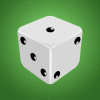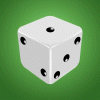Dice History |
|
IntroductionDice (singular die) are thought to be the oldest gambling device invented by man. Dice similar to modern ones have been found in Egyptian tombs built more than 4000 years ago. Nowadays, dice are often made of plastic, but many materials have been used: wood, glass, bone, stone and ivory. Although there are many shapes of dice, the traditional spotted cube is the most common with each face having a number of dots ranging from 1 to 6. The opposite faces of a traditional dice add up to seven, so 1 is opposite 6, 2 is opposite 5 and 3 is opposite 4. This arrangement gives rise to two possible configurations of the spots on the dice - left-handed and right-handed. One is the mirror image of the other. To explain, the faces represting 1, 2 and 3 meet at a common vertex of the cube. If these numbers run clockwise the die is left-handed, if counter-clockwise it is right-handed.
Cheating with DiceEver since dice have been used for gambling, people have tried to cheat. In order not to make the cheating obvious, the cheat doesn't want to win all the time, but the odds need to be tipped in his favor. Perfect dice are known as levels or squares, but dice can be carefully shaped so that they are not perfect cubes - a die will tend to land on the biggest faces. Faces can also be made slightly convex, so that the die is less likely to settle on those faces. Dice that are not perfect cubes are known as shapes, bricks or flats. Dice can be weighted to make it more likely that a certain number comes up, but nowadays transparent dice are used for serious gambling so that the players can see that they are made of a uniform construction. Another trick is to duplicate faces on a pair of dice, so that certain number combinations never come up. It's not obvious to spot, because all the numbers are present between the two dice. Experienced cheats can introduce these crooked dice into a game by sleight of hand, so novice gamblers beware.
Precision DiceDice used in casinos for games such as craps, are translucent or transparent which allows the gambler to see that they have not been tampered with. In order to maintain perfect balance, the dots are drilled into the dice and then filled flush with a paint of the same density as the main material. The dice come in sets with a serial number to prevent substitution during a game. |


